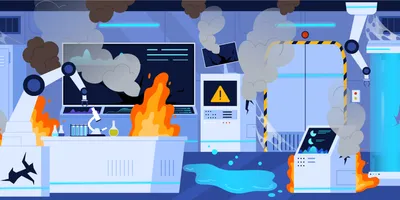Fire remains a common and serious hazard in laboratory environments. The combination of flammable liquids, ignition sources, electrical equipment, and reactive materials makes vigilance essential for anyone working at the bench.
Despite improvements in facility design and safety protocols, data suggest that many researchers still underestimate fire risks. According to the National Fire Protection Association (NFPA), awareness and training gaps persist across research settings. A Nature Chemistry survey found that about one in four researchers had never received training specific to the hazards they handled, and more than a quarter said they never conducted a risk assessment before starting an experiment.
These findings reinforce what OSHA’s Laboratory Safety Guidance has long emphasized: fire prevention depends not only on infrastructure and equipment, but also on consistent safety habits and supervision. While large-scale incidents are rare, small fires remain relatively common, often starting when routine work meets a moment of inattention. Understanding how these fires start and how to prevent them is key to protecting both personnel and research.
Flammable liquids and vapors
Flammable and combustible liquids such as ethanol, acetone, and hexane are among the primary causes of laboratory fires. Vapors from these solvents can ignite from static discharge, hot surfaces, or open flames, even several feet away. Once ignited, they can spread rapidly and produce highly toxic combustion products.
OSHA advises laboratories to keep only the minimum quantities necessary in the work area and to store bulk supplies in approved flammable-liquid storage cabinets. Proper ventilation is essential—vapors should be handled inside a certified fume hood, and solvent transfers should be bonded and grounded to prevent static buildup.
Even simple housekeeping measures, such as tightening bottle caps, separating incompatible chemicals, and labeling secondary containers, can significantly reduce the risk of flash fires.
Ignition sources and heat-producing equipment
Open flames, hot plates, and malfunctioning electrical equipment remain frequent ignition sources in laboratories. OSHA recommends limiting open-flame use to fume hoods and only when the procedure is constantly attended.
Whenever possible, substitute burners and alcohol lamps with safer alternatives such as electric micro-incinerators or pre-sterilized instruments. Keep combustible items—wipes, gloves, and towels—away from heat sources, and never use hot plates to heat solvents. Allow all heating devices to cool completely before storage, and verify that automatic shut-offs are functional.
Even small changes, like posting “heat hazard” signage near benchtop equipment, can remind staff to pause before starting a procedure.
Electrical and battery hazards in the lab
The typical lab depends on high-power instruments, multiple outlets, and portable devices—all of which introduce electrical fire risks if not managed correctly. OSHA’s electrical standard requires that equipment be free from recognized hazards, properly grounded, and maintained according to manufacturer instructions.
Damaged cords, overloaded circuits, and unapproved adapters are common sources of ignition. Routine inspections should identify frayed cables, while extension cords and power strips must be treated as temporary solutions, not permanent wiring.
As labs increasingly rely on portable or rechargeable equipment, lithium-ion battery management has become critical. OSHA recommends charging only on non-combustible surfaces, using certified chargers, and removing damaged or swollen packs from service immediately.
Lab Safety Management Certificate
The Lab Safety Management certificate is more than training—it’s a professional advantage.
Gain critical skills and IACET-approved CEUs that make a measurable difference.
The role of housekeeping and training
Cluttered benches, open containers, and blocked egress routes can turn a small spark into a dangerous fire. OSHA stresses the importance of maintaining clear aisles and keeping access to safety showers, fire extinguishers, and alarms unobstructed. Regular cleanup not only reduces ignition risk but also helps workers recognize when something looks out of place.
Equally important is training. Every lab should have a written emergency plan that is regularly practiced through drills. OSHA endorses the “RACE” procedure as a simple framework for response:
- R – Rescue or remove anyone in danger
- A – Activate the alarm system
- C – Confine the fire by closing doors
- E – Evacuate or extinguish if trained to do so
Knowing the nearest exit, alarm pull, and fire extinguisher location can make the difference between containment and escalation.
Building a culture of prevention
Preventing laboratory fires is not solely about compliance—it’s about culture. When lab managers model safe behaviors, conduct regular walkthroughs, and reinforce attention to detail, those actions set the tone for the entire team.
Creating this culture means shifting the focus from reacting to incidents to anticipating them. Each step—minimizing materials, maintaining equipment, or conducting refresher training—builds layers of protection that keep people and science safe.












